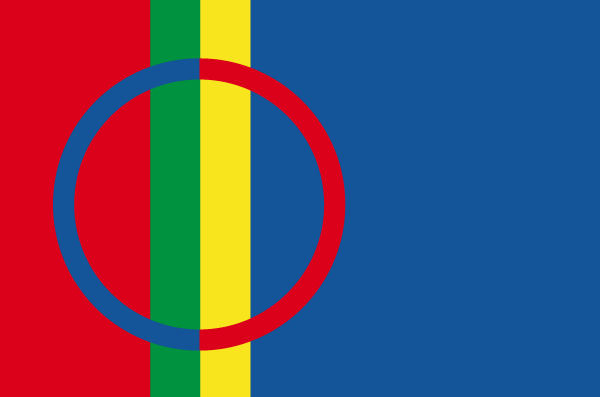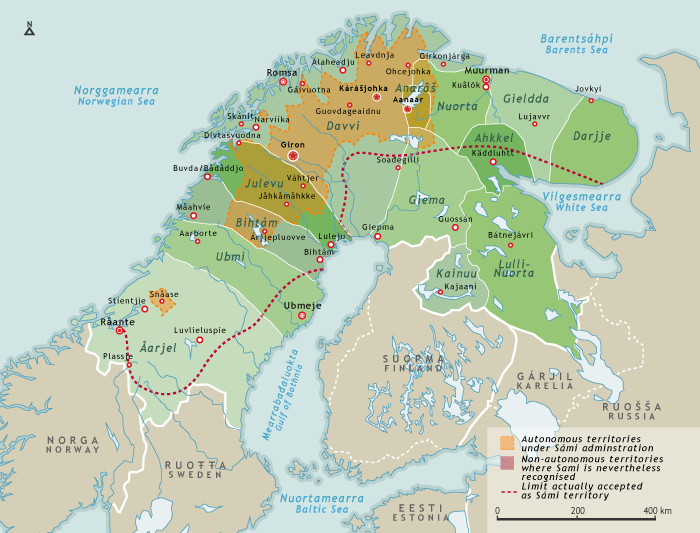Sápmi, shepherds of the Boreal Lands

The Sámi have one of the most extensive territories in Europe. This land, called “Sápmi”, stretches from the north of Sweden, Norway, Finland and on the Kola peninsula in Russia. Their language, Sami, is spoken in many groups.

For thousands of years, the Sámi lived on hunting and fishing to the north of the European continent. It wasn’t until around the year 900 AD that they began to herd tamed reindeer, henceforth considered their traditional way of life. They maintain a special relationship with nature, living in harmony with it. Thus, the Sámi community was traditionally based on the siida, i.e. the units and collectivities of common law (not necessarily familial), which use their own council and administration, allocating hunting grounds and fishing.
The colonisation of Sápmi (Lapland) and the exploitation of resources were considerably increased over the course of the 13th and 14th centuries, causing many states to claim their sovereignty over this region. The first stage of this division split the territory the length of the mountain ridges from the region of Jämtland to Finnmark The border between Sweden and Finland was established in 1809 and that between Norway and Russia in 1826.
Over the course of the past two centuries, the Sámi have been the victims of repression and negligence of the people who ruled them, who considered them to be inferior. For example, the well-known term “Lapon” is used in a derogatory manner by the population (“lapp” being an old Scandinavian term used to describe a worn piece of clothing or “lape” in vernacular Finnish). The banning of cultural expression and the speaking of the Sami language intensified in the 19th century. It is only since the 1980s that the Sámi have made a remarkable return to the public scene, allowing them to develop their autonomy peacefully and to enforce their identity.

Identity card

| Name | Sápmi/Sámeedna | Sami/Lapon Sameland/Lappland | Swedish, Norwegian Lappi | Finnish Лапландия/Laplandiya | Russian (Sápmi / “Laponia”) |
| Population | 2,979,938 inhab. (of which 100,000 Sámis) |
| Area | 669,646 km² |
| Languages | Sámegielat | Sami/Lapon Svenska | Swedish Norsk | Norwegian Suomi | Finnish Русский/Russkiy | Russian (offical) |
| Number of native speakers | 25,000 | Sami/Lapon |
| State of guardianship | Sweden, Norway, Finland, Russia |
| Official status | Represented by a parliament in Sweden, Norway and Finland, no particular status in Russia |
| Capital | Giro | Sami/Lapon Kiruna | Swedish (Suède) & Kárášjohka | Sami/Lapon Karasjok | Norwegian (Norway) & Áanaar | Sami/Lapon Inari | Finnish (Finland) |
| Historic religion | Christian and Animist |
| Flag | Sámi leavg | Sami/Lapon (Sámi Flag) |
| Anthem | Sámi soga lávll | Sami/Lapon (Song of the Sámi People) |
| Motto | Sámieatnan sámiide | Sami/Lapon (A Sámi Land for the Sámi People) |

Timeline

- 1600 • Denmark, Sweden and Russia establish tax in the north of the Sámi territory.
- 1751 • Despite the establishment of a border between Norway and Sweden-Finland, rights are granted to the Sámi to live and move freely.
- 1852 • The town of Guovdageaidnu experiences one of the rare Sámi rebellions against the Norwegian oppressor.
- 1963 • The Sami language is newly authorised in Norwegian schools.
- 1979 • Controversy around a hydroelectric project in Norway, which enables the Sámi to have new rights. Creation of the first Sámi sport federation.
- 1986 • The Sámi conference decrees that Sápmi is Sámi territory and should be treated with respect and care. Creation of the national anthem and the flag.
- 1989–96 • First Sámi parliaments in Norway, Sweden and Finland, with limited powers.
- 2005 • Law on the Finnmark, granting extensive rights to Sámis in the northernmost part of Norway.

Brief history

The first joint conference of the Sámi parliamentaries took place in Jåhkåmåhkke on 24 February 2005. The representatives of the Sámi parliaments in Norway, Sweden, Finland and Russia participated. It was during this historic event that they assert that the Sámi are a united people, whose unity cannot be challenged by state borders. The declaration states, among other things, the right to self-determination by the Sámi people and the fact that important work is to be carried out to complete the “Nordic Sámi contract”. Since this date, the Sámi parliaments have met every three years.

Geography

The territory of the Sámi is called Sápmi. It corresponds to the north of Scandinavia, Finland and the Kola Peninsula in Russia. Essentially made up of arctic landscapes, the boreal forests (taiga) and the arid plains (tundra) follow one another. The forests of taiga are principally made up of conifers, dominated by larch, spruce, fir and pine. The tundra is a landscape of lichens and cropped vegetation, a source of food for the reindeer. The coast, where the big towns are located, benefits from a more temperate climate. To the north, the coast is not covered with ice-sheets because of the effect of the warm current of the Gulf Stream from the south of the Atlantic. Islands and fjords dominate the coastal landscape. The Gulf of Bothnia is covered with ice all winter. A long chain of mountains follows the coast from north to south and separates the areas, which were previously used by nomads to herd reindeer.



Language

Sámegiella
The Sami language is a group of 12 Finno-Ugric linguistic variants, belonging to Finnish (six are still active, three are in serious danger of extinction and three are extinct). Three groups are dominant (to the south, Ume and southern Sami; Pite, Lule and Sami to the north; to the east, Enare, Skolt, Akkala, Kildin, Ter, Kemi and Kainuu). Significant differences exist between these three linguistic groups. Inter-comprehension is difficult, if not sometimes impossible. The variants of Akkala, Kemi et Kainuu are extinct and those of Ume, Pite and Ter are in serious danger of extinction. Northern Sami is the most common variety and is often used for radio programmes as well as in numerous publications. It is becoming the language of communication of the Sámi people.

Politics now

The Sámi have become aware of the originality of their culture and that a plan to safeguard it is necessary. Proud of an identity often classing them as a primary nation, they are now organised to better defend their interests and those of their land. Even if relations were already possible between Sámi repatriated among Sweden, Norway and Finland, it is only a couple of decades since contact was established with Sámi in Russia, after years of long isolation. The Sámi are legally protected and benefit from an area of administration, which is dedicated to them. However, in Sweden the farmers and the forestry companies call into question the right to reindeer grazing. Only 10% of the population herd reindeer, often contrary to common assumptions.

